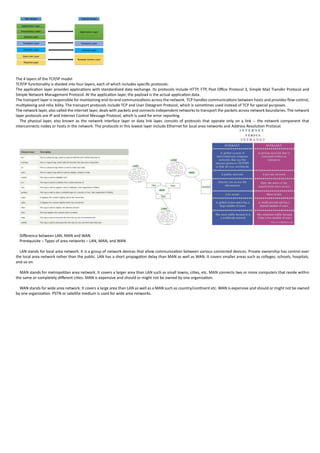The 4 layers of the TCP model It related computer .docx
•Download as DOCX, PDF•
0 likes•3 views
TCP 4 layers
Report
Share
Report
Share

Recommended
Recommended
More Related Content
Similar to The 4 layers of the TCP model It related computer .docx
Similar to The 4 layers of the TCP model It related computer .docx (20)
Recently uploaded
Recently uploaded (20)
1111 ChatGPT Prompts PDF Free Download - Prompts for ChatGPT

1111 ChatGPT Prompts PDF Free Download - Prompts for ChatGPT
JavaScript Usage Statistics 2024 - The Ultimate Guide

JavaScript Usage Statistics 2024 - The Ultimate Guide
Frisco Automating Purchase Orders with MuleSoft IDP- May 10th, 2024.pptx.pdf

Frisco Automating Purchase Orders with MuleSoft IDP- May 10th, 2024.pptx.pdf
(Explainable) Data-Centric AI: what are you explaininhg, and to whom?

(Explainable) Data-Centric AI: what are you explaininhg, and to whom?
Intro to Passkeys and the State of Passwordless.pptx

Intro to Passkeys and the State of Passwordless.pptx
How to Check CNIC Information Online with Pakdata cf

How to Check CNIC Information Online with Pakdata cf
State of the Smart Building Startup Landscape 2024!

State of the Smart Building Startup Landscape 2024!
Harnessing Passkeys in the Battle Against AI-Powered Cyber Threats.pptx

Harnessing Passkeys in the Battle Against AI-Powered Cyber Threats.pptx
The Zero-ETL Approach: Enhancing Data Agility and Insight

The Zero-ETL Approach: Enhancing Data Agility and Insight
Revolutionizing SAP® Processes with Automation and Artificial Intelligence

Revolutionizing SAP® Processes with Automation and Artificial Intelligence
ChatGPT and Beyond - Elevating DevOps Productivity

ChatGPT and Beyond - Elevating DevOps Productivity
The 4 layers of the TCP model It related computer .docx
- 1. The 4 layers of the TCP/IP model TCP/IP functionality is divided into four layers, each of which includes specific protocols: The application layer provides applications with standardized data exchange. Its protocols include HTTP, FTP, Post Office Protocol 3, Simple Mail Transfer Protocol and Simple Network Management Protocol. At the application layer, the payload is the actual application data. The transport layer is responsible for maintaining end-to-end communications across the network. TCP handles communications between hosts and provides flow control, multiplexing and relia bility. The transport protocols include TCP and User Datagram Protocol, which is sometimes used instead of TCP for special purposes. The network layer, also called the internet layer, deals with packets and connects independent networks to transport the packets across network boundaries. The network layer protocols are IP and Internet Control Message Protocol, which is used for error reporting. The physical layer, also known as the network interface layer or data link layer, consists of protocols that operate only on a link -- the network component that interconnects nodes or hosts in the network. The protocols in this lowest layer include Ethernet for local area networks and Address Resolution Protocol. Difference between LAN, MAN and WAN Prerequisite – Types of area networks – LAN, MAN, and WAN LAN stands for local area network. It is a group of network devices that allow communication between various connected devices. Private ownership has control over the local area network rather than the public. LAN has a short propagation delay than MAN as well as WAN. It covers smaller areas such as colleges, schools, hospitals, and so on. MAN stands for metropolitan area network. It covers a larger area than LAN such as small towns, cities, etc. MAN connects two or more computers that reside within the same or completely different cities. MAN is expensive and should or might not be owned by one organization. WAN stands for wide area network. It covers a large area than LAN as well as a MAN such as country/continent etc. WAN is expensive and should or might not be owned by one organization. PSTN or satellite medium is used for wide area networks.
